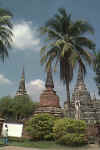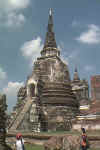Ayutthaya—A
City With a Past Worth Preserving
The spectacular ruins of this nearby city are definitely worth the day trip.
However, to really experience the site, plan on an overnight trip. Catch the
ruins in the morning, take a swim in the afternoon, and then return for great
late afternoon photo ops.
 Ayutthaya
is now a provincial city about 86 kilometers north of Bangkok, but for 417 years
it was the capital of Siam with sovereignty extending into modern-day neighbors
Laos, Cambodia and Myanmar (Burma). And, unlike many modern Asian cities, it was
well planned.
Ayutthaya
is now a provincial city about 86 kilometers north of Bangkok, but for 417 years
it was the capital of Siam with sovereignty extending into modern-day neighbors
Laos, Cambodia and Myanmar (Burma). And, unlike many modern Asian cities, it was
well planned.
King
Ramathibodi I, who was escaping a smallpox outbreak in Lop Buri, founded the
city in 1350. Ayutthaya’s influence spread quickly. China became a major
trading partner and by the early 16th Century the Portuguese had
established a treaty with Siam—and introduced the hot chilies from South
America that are now a staple of many Thai dishes. French, Dutch and other
European countries followed. The glory ended abruptly in 1767 when the Burmese
sacked and burned the city.
During
its reign, while Ayutthaya grew rapidly it was also well managed. At one point
in the 16th Century, the brick walls encircling the city were five
meters (17 feet) thick and six meters (20 feet) high. Ninety-nine gates peppered
the 12.5-kilometer (about 10 miles) wall. Twenty were dedicated to water flow
only. More
than ten canals were constructed along North/South and East/West axes. Floating
markets were situated in each quadrant of the city. Thirty bridges, brick and
clay roads made transportation easier for the inhabitants and visitors.
Ayutthaya
planners even provided for the thousands of Farang who flocked to Siam each year
for some mercantile, political or religious purposes, Each foreign group was
allocated an area outside the central city where they could observe their own
cultural and religious practices.
Much
of the past glory can still be admired today, as well as a hint of what Bangkok
may have been like decades ago. There is much more open space in Ayutthaya.
Empty green fields break up the urban monotony; slender palm trees catch the
sun’s rays. Traffic is not overwhelming.
Tours
leave from Bangkok daily but for do-it-yourselfers, air-conditioned buses run
every 20 minutes or so from the Northern bus terminal. A train from Hualamphon
station departs every hour. In all cases, plan for 1 ˝ to 2 hours for the trip.
Rates will be under $2 US.
 The
ruins are scattered throughout the city. Tuk-tuks can be hired or bicycles can
be rented from any of the guesthouses, where local maps are also available.
Long-tail boats can be hired to tour canals and outlying wats. Negotiate and
plan on 4-500 baht for up to eight. Many sites charge a 30 baht admission fee.
The
ruins are scattered throughout the city. Tuk-tuks can be hired or bicycles can
be rented from any of the guesthouses, where local maps are also available.
Long-tail boats can be hired to tour canals and outlying wats. Negotiate and
plan on 4-500 baht for up to eight. Many sites charge a 30 baht admission fee.
AYUTTHAYA
Central
Ruins include: Wat Phra Si Sanphet, Wat Mongkhon Bophit and Wat Phra Mahathat
Transportation
from Bangkok: Bus, train, tour or hired car.
Hotels
include: U-Thong Inn (035-242-236) with air-conditioned rooms and swimming pool.
Rooms from about 1400 baht.
Return
to Travel Page. Return to Home
Page.

©
2001 Michael Williams. All Rights Reserved.
Email
Webmaster: thaimexico@tripod.com
Last
updated: March 8, 2003.
 Ayutthaya
is now a provincial city about 86 kilometers north of Bangkok, but for 417 years
it was the capital of Siam with sovereignty extending into modern-day neighbors
Laos, Cambodia and Myanmar (Burma). And, unlike many modern Asian cities, it was
well planned.
Ayutthaya
is now a provincial city about 86 kilometers north of Bangkok, but for 417 years
it was the capital of Siam with sovereignty extending into modern-day neighbors
Laos, Cambodia and Myanmar (Burma). And, unlike many modern Asian cities, it was
well planned.